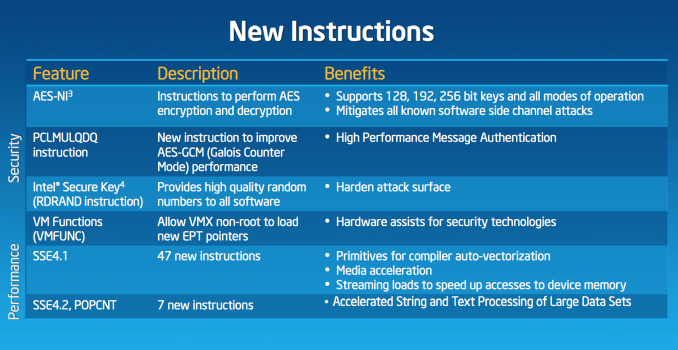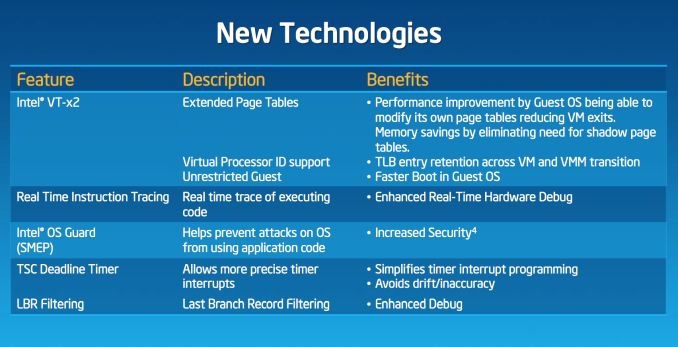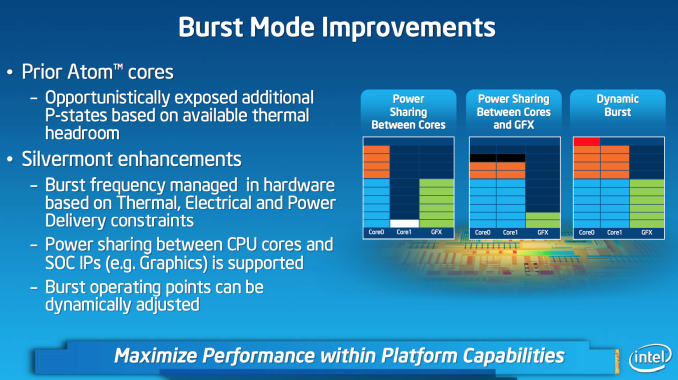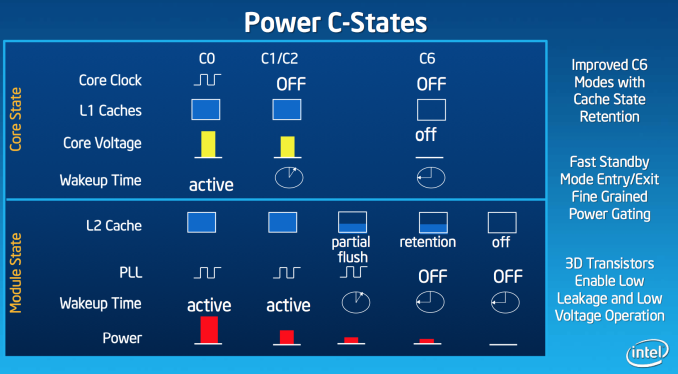Intel’s Silvermont Architecture Revealed: Getting Serious About Mobile
by Anand Lal Shimpi on May 6, 2013 1:00 PM EST- Posted in
- CPUs
- Intel
- Silvermont
- SoCs
ISA
The original Atom processor enabled support for Merom/Conroe-class x86 instructions, it lacked SSE4 support due to die/power constraints; that was at 45nm, at 22nm there’s room for improvement. Silvermont brings ISA compatibility up to Westmere levels (Intel’s 2010 Core microprocessor architecture). There’s now support for SSE4.1, SSE4.2, POPCNT and AES-NI.
Silvermont is 64-bit capable, although it is up to Intel to enable 64-bit support on various SKUs similar to what we’ve seen with Atom thus far.
IPC and Frequency
The combination of everything Intel is doing on the IPC front give it, according to Intel, roughly the same single threaded performance as ARM’s Cortex A15. We’ve already established that the Cortex A15 is quite good, but here’s where Silvermont has a chance to pull ahead. We already established that Intel’s 22nm process can give it anywhere from a 18 - 37% performance uplift at the same power consumption. IPC scaling gives Silvermont stable footing, but the ability to run at considerably higher frequencies without drawing more power is what puts it over the top.
Intel isn’t talking about frequencies at this point, but I’ve heard numbers around 2 - 2.4GHz thrown around a lot. Compared to the 1.6 - 2GHz range we currently have with Bonnell based silicon, you can see how the performance story gets serious quickly. Intel is talking about a 50% improvement in IPC at the core, combine that with a 30% improvement in frequency without any power impact and you’re now at 83% better performance potentially with no power penalty. There are other advantages at the SoC level that once factored in drive things even further.
Real Turbo Modes & Power Management
Previous Atom based mobile SoCs had a very crude version of Intel’s Turbo Boost. The CPU would expose all of its available P-states to the OS and as it became thermally limited, Intel would clamp the max P-state it would expose to the OS. Everything was OS-driven and previous designs weren’t able to capitalize on unused thermal budget elsewhere in the SoC to drive up frequency in active parts of chip. This lack of flexibility even impacted the SoC at the CPU core level. When running a single threaded app, Medfield/Clover Trail/et al couldn’t take thermal budget freed up by the idle core and use it to drive the frequency of the active core. Previous Atom implementations were basically somewhere in the pre-Nehalem era of thermal/boost management. From what I’ve seen, this is also how a lot of the present day ARM architectures work as well. At best, they vary what operating states they expose to the OS and clamp max frequency depending on thermals. To the best of my knowledge, none of the SoC vendors today actively implement modern big-core-Intel-like frequency management. Silvermont fixes this.
Silvermont, like Nehalem and the architectures that followed, gets its own power control unit that monitors thermals and handles dynamic allocation of power budget to various blocks within the SoC. If I understand this correctly, Silvermont should expose a maximum base frequency to the OS but depending on instruction mix and available TDP it can turbo up beyond that maximum frequency as long as it doesn’t exceed TDP. Like Sandy Bridge, Silvermont will even be able to exceed TDP for a short period of time if the package temperature is low enough to allow it. Finally, Silvermont’s turbo can also work across IP blocks: power budget allocated to the GPU can be transferred to the CPU cores (and vice versa).
By big-core standards (especially compared to Haswell), Silvermont’s turbo isn’t all that impressive but compared to how things are currently handled in the mobile space this should be a huge step forward.
On the power management side, getting in and out of C6 should be a bit quicker. There's also a new C6 mode with cache state retention.















174 Comments
View All Comments
Jaybus - Monday, May 13, 2013 - link
In the full Win 8 tablet market, I don't think any low power SoC is going to be adequate to compete against 13 W Ivy Bridge.1d107 - Tuesday, May 7, 2013 - link
Did I miss memory bandwidth comparison with A6X? Will it support hi-res displays with acceptable performance? And by performance I mean not playing Angry birds on a so 1366x768 or even 1080p, but smooth scrolling and fast text rendering on a 3840x2400 screen. This would be cool for a descent Windows tablet with an external display attached.I'm afraid that by the time Silvermont is released and incorporated into actual products, Apple will have iPad 5 already shipping with A7X chip that will have twice the battery life, while maintaining better performance than A6X. They will need it for the iPad mini, but full-sized iPads will benefit also.
fteoath64 - Tuesday, May 7, 2013 - link
One cannot know what the A7X can deliver but can take a couple of guesses. Here: 1) Optimise Swift further with pipeline shortening but still staying on A9 architecture, 2) Leap to A15 dual core with minimal optimization. On gpu side, it becomes more tricky as Pvr554 being used is Max out at 4 cores, they would have to either jack that up(6 cores ?) or jack up the clock rate.Remember that S800 and T4 products are yet to be announced so there is some time to watch the progression.
Intel's key weakness here is STILL on gpu side. To put 3 cores of PVR 554 would eat a lot of power while giving it respectable performance. Going 1/4 HD4000 is just a dumb idea as the drivers are very bad and will remain so. Again too much power budget to slot in 8EU on SIlvermont quad.
On thing is for sure: Silvermont is going to make a wicked NAS cpu!.
thunng8 - Wednesday, May 8, 2013 - link
1) Swift is not A9 architecture.2) A7X will likely get the next generation PVR graphics chip (SGX Series 6 aka Rogue).
nunomoreira10 - Wednesday, May 8, 2013 - link
considering the power budget, 1/4 hd4000 is quite goodhd4000 consumes around 10w during games, 1/4 with clock cut down and power improvements we should expect 1-2w which is the max they could allow.
drivers are good for the games normally played on tablets.
BSMonitor - Tuesday, May 7, 2013 - link
Awesome review! This is the one we have been waiting for from Windows Phone / Windows Tablets!!Anand, is it the next Lumia that Intel has scored a design win?? x86 Windows 8 on a next gen Lumia??
warezme - Wednesday, May 8, 2013 - link
Sounds like Intel is going hammer time on the mobile SOC arena. It's gonna get ugly but very interesting.futbol4me - Wednesday, May 8, 2013 - link
Can someone out there answer a few questions for me?(1) If Intel Atom powered tablet were running android, do APPS available on Google Play need to be recompiled for the platform?
(2) Will a Windows8 Intel Atom powered tablet have enough horsepower to run android effectively as a Virtual Machine?
Do you think there is enough
biertourist - Wednesday, May 8, 2013 - link
To answer Question #2: Yes. Current Intel Atom tablets can run Android apps ala the "BlueStacks" app currently.rootheday - Thursday, May 9, 2013 - link
re #1, Android apps written in Dalvik/Java require no recompile because they are compiled against a virtual machine spec. Android apps written as "native" against ARM instruction set -> Intel has implemented a binary translation capability called Houdini that converts them to x86 on the fly and optimizes them in the background.